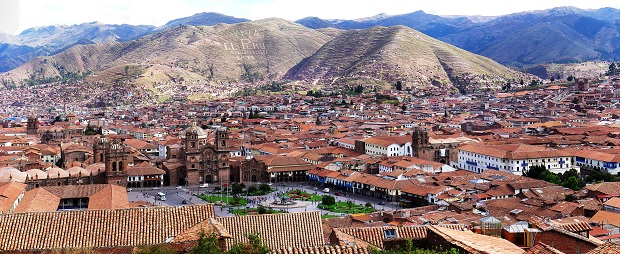Alasdair Lawrence writes about Cusco, Peru and why it’s one of the most interesting cities in the world.
For me one of the most beautiful cities on earth would be Cusco, Peru. If you think you’ve heard that name before you may be thinking of Kuzco from Disney’s The Emperor’s New Groove. He was named after the city as it was the capital of the Inca Empire. ‘Cusco’, fun fact, is Quechua (‘Incan’) for ‘navel’ or belly-button because it was the centre of the empire and the universe. But enough with the dictionary definition; Cusco is nestled high up in the Andean Mountains and is a short journey away from the Urubamba Valley – home to the world-famous Machu Picchu.
Part of Cusco’s charm is its blending of pre- and post-Hispanic Peru. Whilst the history of the conquest of the Inca Empire might be a little bit on the depressing side, today both cultures – Hispanic and Quechua – flourish in joint partnership. A striking example of Cusco’s mixed traditions is its houses. Inca buildings are famous for their seamlessness – giant boulders ground down into angled shapes that fit together like jigsaw pieces.
When the Spanish flew through Cusco they sadly destroyed the city but the foundations of the buildings remained. Today beautiful, almost clichéd, Spanish villas with white walls and orange terracotta tiles sit atop grand, grey Inca architecture. It’s almost a metaphor.
Cusco’s main square, the Plaza de Armas, is pretty neat, too. Two of its four sides are dominated by giant cathedrals. Yes, for some reason the Peruvians thought it was good sense to build two enormous gothic cathedrals next to one another. One is known simply as ‘the Cathedral’ and the other, almost sinisterly, ‘The Company’. Inside ‘the Cathedral’ one can not only see magnificent church architecture and beautiful, cavernous halls but also an indigenous adaptation of Christian art – specifically ‘the Last Supper’ of Jesus and his disciples feasting on some maize and guinea pig.
Atop Cusco’s snug little valley stands one of the greatest Inca monuments remaining – Saqsaywaman. Pronounced almost identically to ‘Sexy Woman’, Saqsaywaman is a giant Inca fort or castle left by the invasion of Cusco by the conquistadors. To build it, boulders the size of houses were dragged up the hill from the valley floor and chiseled to a perfect fit. It’s as impossible to conceive as it is to behold – a testimony to the sophistication and manpower of the Inca Empire.
Cusco is a city steeped in history, built on history and fed on history. It is well worth a visit.




